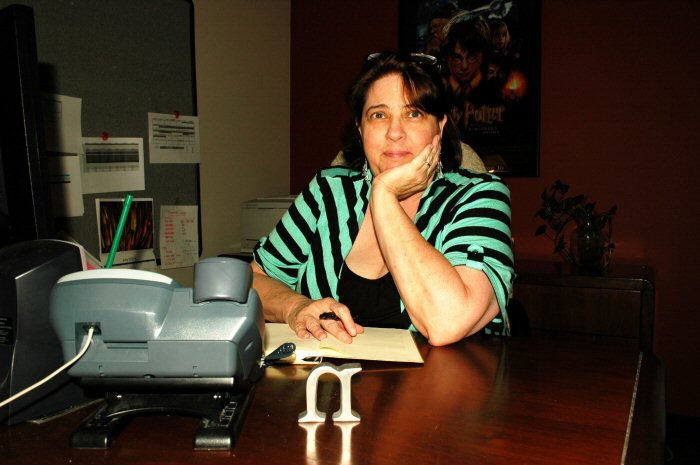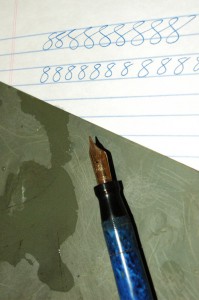For the longest time, dead people were the sole focus of our “Famous People & Pens” series. Then I got it through my thick skull that many of our living customers are actual working writers, and…HEY!…why not profile them and their work?!
There is a reason I was never hired as a rocket scientist by NASA.
Starting today, I will profile the first of many writers and famous, or soon-to-be-famous, people who love fountain pens and other luxury writing instruments. I will absolutely continue to find the stories behind historical figures and their favorite pens, but my live interviews are hopefully going to rock your world.

Nan Sampson, author of Restless Natives, ponder’s her next story idea while holding her Waterman Phileas fountain pen.
Without further ado, let me introduce you to Nan Sampson. Nan has just published her very first novel: “Restless Natives.” It is a murder mystery that is now available for a Kindle download on Amazon. Her book released last week. Although this is her first published novel, she has been writing for her entire life and is a marketing executive in the Chicagoland area.
As a pen collector, she has a penchant for Waterman and Pelikan pens. She also has a thing for green Sheaffer’s Scrip from the 1950s.
DRIPPY MUSINGS: Hi, Nan. Welcome to ThePenMarket.com’s Drippy Musings. How does it feel to have your first novel published and available on Amazon?
NAN SAMPSON: It is amazing. A lifetime dream come true. Although the biggest realization has been that now that I’ve had my moment of celebration, the work goes on. Book two in the series awaits, plus I’ve other projects lined up, like planes circling O’Hare!
DM: Tell us a little about “Restless Natives.”
NS: It’s a cozy mystery, set in a small fictional town in southwestern Wisconsin. Oddly enough, the main character used to be a marketing executive in Chicago. Hmm… Seriously, though it’s a lot of fun, lots of quirky characters and a rather odd murder. A poor fellow gets tarred with pancake syrup and covered with chicken feathers. Oh, and gets a great bloody knife in the chest, too. Details…
DM: Where did you first get the idea for this book?
NS: I’ve always wanted to create a series set in a town that I’d want to live in, like Long Piddleton (from the Richard Jury novels by Martha Grimes) or the village of Finch (from Nancy Atherton’s Aunt Dimity series). A place readers can escape to, filled with familiar faces and quirky problems. And having spent a great deal of time in southwestern Wisconsin and meeting great people there, it just sort of fell into place.
DM: Every writer approaches their job differently. What is your process? What is your motivation?
NS: My motivation. [chuckles] ‘I’m ready for my close-up now, Mr. DeMille.’ I’ll tackle process first. I’m a life-long “panster” — meaning I do things by the seat of my pants. I’m not one for long outlines — I find in creating those, I feel like I’ve “done” the book and I lose my enthusiasm. So I start with a beginning, figure out my ending (although it can change during the actual writing process — it’s more of a direction to head in), and usually have a couple of juicy scenes in the middle that I’m anxious to write to keep me going. Rewrites can be a bear as things are pretty loosey-goosey and the story I start out writing is often very different from the one I end up with. It’s hard for me to see the whole of the tapestry until I’m finished with it. So I’m not sure I’d recommend my process to others. But it works for me.
My motivation? Gosh. Being a writer, telling stories, making up worlds and characters and languages and stuff…that’s just who I am. I don’t know how to be any other way. I cannot imagine living without doing those things. It will be great to get paid for it, but I’d be doing it anyway, even if no one ever buys my work. I love it. But I’m also not one of those writers that thinks earning money will “cheapen my art”. Please – go out and buy my book! In fact, buy several copies and gift them to your friends and relatives at the holidays! I have a child to put through college. [Laughs]
DM: How did you get into writing? Were you always a storyteller, or did you cultivate this interest over time?
NS: My mother said I told stories to my stuffed bear in my crib. That is, perhaps, a slight exaggeration. But I cannot remember a time when I wasn’t concocting stories in my head, trying on different personas and pretending to live other lives. I believe clinical psychologists call that a “personality disorder”. Or maybe delusional. Either way, I guess I’m okay with that. [Laughs]
DM: Who were and are some of your biggest influences as a writer? Why?
NS: Oh, that is a long list. I’ll try to just cover the biggies. First and foremost was Roger Zelazny. He was brilliant, innovative and knew the rules well enough to break them in clever, ingenious ways. Carl Sagan and Asimov are up there too — they were both genius at taking complex subjects and making them both accessible and interesting to the ordinary person. I cut my teeth on Dorothy L. Sayers and Agatha Christie — the grand dames of the cozy mystery. I love [Sir Arthur] Conan Doyle, too. I always have Holmes with me on my Kindle — a go-to for times when you just need the comfort of the familiar or a great character.
From a more contemporary perspective, I’m totally in love with Gini Koch — she has this wry humor, but knows how to keep the action flying as well. Lois McMasters Bujold is also fab and taught me all about character arcs and unlikely heroes. And I’ll read almost anything by Glenn Cook — more dry wit. Gosh, most everyone I’ve mentioned is either fantasy or science fiction. I do read a lot in those genres. James Rollins, action/adventure, is the master at interweaving story lines and pacing.
How much time do we have? [Chuckles] I’ll stop there. Suffice it to say I read widely. But Roger… well, Roger was a god to me. He taught me that my crazy ideas were okay. He was simply amazing, and highly under-appreciated.
DM: Do you compose longhand or on the computer?
NS: I compose on the keyboard. I need to be able to type as fast as I think. Revision is done long hand, and I make all my character notes and so forth in pen. I do a lot of brainstorming and idea mapping by hand, as well. And yes… all in green ink. My fingers are always stained with green.
DM: What are your favorite pens? Why?
NS: I LOVE my Waterman [Phileas]. The barrel is wider, so my fingers don’t cramp, and it has a really smooth flow. I hate scratchy pens. My handwriting is atrocious. Only my best friend can read it, and I write very quickly. The pen needs to be able to keep up and not skip or scratch along the page. And of course, the barrel has that green marbling — the green thing again! The one I have my eye on from your website it that gorgeous vintage 0655 Conklin Endura. Wow. Stunning. Love the coloration of the barrel. But unless a whole bunch of your fans and friends buy my book, that’s a wee bit out of my league.
DM: How did you get into fountain pens?
NS: My pop used to take me to auctions and estate sales when I was little. Back in those days, when dinosaurs roamed the earth, there were always three things you could always find in large quantities — old keys (you know, skeleton keys), raggedy stuffed animals and fountain pens. You could buy them by the box! I would always get to buy one of each (kept me pacified, I suppose). I’d bring along a notepad and scribble (without ink of course) with the pens, pretending to be a famous author giving my autograph to the stuffed animals. There’s something magical about fountain pens that make you think anything is possible — they’re elegant and old world and for some odd reason they give me a sense of confidence. Of permanence. I guess I’m a bit old fashioned — heck I still have an old Underwood typewriter that I bang on occasionally.
DM: What types of ink do you like best? Why?
NS: I’m not much of an ink snob. But I don’t like a lot of smearing (it’s always getting on my hands) so a quick drying ink is good. And it has to flow smoothly and not clog up my pen a lot. But most importantly, it has to be green. Emerald green. I’m open to recommendations, O Great Pen Guru. *nudge nudge wink wink*
DM: Okay. So, I know the ink is barely dry on “Restless Natives,” but can you tell us a little about what to expect next?
NS: No rest for the wicked, you know. The physical copy of “Restless Natives” is coming soon (probably a few weeks) and the second book in the current series is written and awaiting revision. That one is slated for publication in January, gods willing and the river don’t rise, as my Gran would have said. I’m also working on a fantasy novel, and have the bare bones of a second mystery series set in a haunted bed & breakfast. Oh, and then there’s this idea I had for an adventure novel set in the ’20s (a la H. Rider Haggard and Indiana Jones) only with a woman heroine. Like I said earlier, I’ve got more ideas than time!
DM: It has been a pleasure speaking with you, Nan. Thank you for taking the time to share your thoughts and pen passions with us at Drippy Musings.
NS: No, thank you! It’s been a joy sharing with you, thanks for inviting me. And as soon as I sell enough books, we’ll have to talk about that Conklin!
Be sure to check out Nan Sampson’s book “Restless Natives” at Amazon.com. It is a fun read, and a great summertime escape while you are lounging by the pool or chillin’ in the shade.


 Shopping Cart
Shopping Cart






